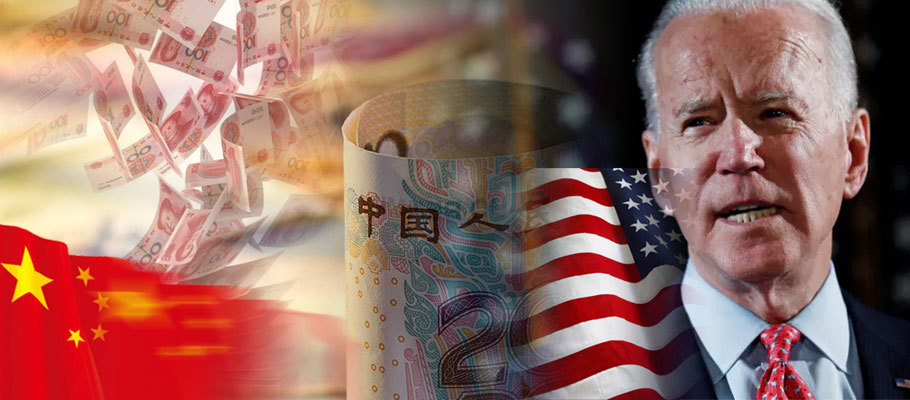
Published: November 14th, 2020
Joe Biden may have won the presidency, but for the $6.5-trillion-a-day forex world, the big winner is the Chinese yuan. Traders and investors are now expecting trade tensions with Washington will fade, and that friendlier relations will enable the yuan’s exchange rate to lift.
All the big investment banks are rushing to revise their forecasts, with predictions that the yuan could revisit highs not seen since early-2018, in the days before current U.S. President Trump began his Chinese trade war.
The yuan rose 0.5 per cent this week in offshore trading to reach a new 2.5-year year high of 6.556 yuan per dollar. Besides the positive political news, analysts put some of the rise down to weaker dollar positioning, along with positive perceptions of China's effective containment of the COVID-19 pandemic and associated economic recovery.
Data showing exports grew in October at their fastest pace in 18 months soothed worries that the world's mightiest export machine was sputtering, even as the yuan held firm for the fifth straight month in offshore trading.
While analysts once saw an exchange rate of seven-per-dollar as potentially transformational, some are now saying it could break below six over by Q3 of next year.
Underpinning that expectation is the idea that Beijing will be less prone to hold the yuan back because of worries about the country's extensive, but shrinking, share of the economy. Data from the World Bank has exports accounting for 18.3 per cent of Chinese GDP in 2019, versus 26 per cent in 2010.
Currency analysts at Morgan Stanley and Goldman Sachs have started advising clients to buy yuan against the sliding dollar. Forecasts from Goldman have the yuan reaching 6.29 per dollar by November 2021, representing a four per cent move if it happens.
Analysts at Citi in New York have established a three-pronged rationale for going long on the yuan: a likely decline in trade tensions thanks to a less-combative Biden administration, general dollar weakness, and China's improved balance of payments account.
America’s Depository Trust and Clearing Corporation (DTCC) reported trades totalling more than $22 billion last week on dollar puts, or derivatives enabling the holder to sell an instrument, versus yuan calls, which provide the right to buy an instrument at a pre-set price.
DTCC data showed strike prices where options can be exercised in the 6.4-6.36 per dollar region this week. The International Institute of Finance said this week that Chinese equities also saw a massive investment inflow once Biden’s victory looked to be secure.
The People's Bank of China (PBOC) has thus far been restrained about the yuan’s recent strength, though it did attempt to reign-in appreciation through the state banks' power to make dollar purchases.
Economists believe a strong yuan will boost Chinese consumers' purchasing power, with the knock-on effect of luring more capital to China’s financial markets. That would suit Beijing's objective of strengthening the yuan's role as a reserve currency.
Despite the belief that a Biden administration will be less belligerent on trade, Chinese authorities may still have battles to win. Washington has long believed Beijing keeps its currency low as a tactical move to subsidise its exports by stealth at the expense of US goods. Those views are unlikely to evaporate with a change of residency at the White House.
As with most non-U.S. dollar investments in emerging markets, forex traders and investors are looking not only the yuan’s yield level but also the potential for appreciation or depreciation.
Analysts at VanEck point to the role of emerging markets bonds, which have historically provided investors with tactical opportunities to find advantage when the greenback experiences weakness. Over the previous four years, currency movements have detracted from total bond returns overall.
They believe, however, that the yuan shouldn’t be grouped into the broad category of emerging markets currencies (EMFX) any longer. It has several characteristics that set it apart, they say, making risk exposure more palatable to global bond investors who might otherwise shy away from EMFX volatility. Those differences would also give a shot to China’s onshore bonds, helping improve their risk-return profile.
Strong and resilient economic growth, particularly this year, has been a vital driver of the yuan’s upward trajectory against the greenback and contrasts the weakness shown by less sturdy emerging markets. The massive Chinese economy and the country’s role in driving economic growth around the globe also make it unique amongst ‘emerging’ economies.
Although no currency can match the dollar in terms of its role in the global economy, yuan’s global role is growing. It now makes up approximately 1.9 per cent of foreign exchange reserve assets, and Morgan Stanley believes that may extend to up to 9.8 per cent by 2028. That would make yuan the third-largest reserve currency, behind the greenback and euro respectively
As China’s economy continues its shift to consumer versus export-led growth, policymakers have also continued the gradual opening of onshore markets to foreign investment. As Beijing’s presence in global equity and bond indices continues to grow, foreign investor inflows may add support for a strengthening yuan.
In the context of a portfolio or index of emerging markets local currency bonds, analysts think the growing weight of China’s onshore bonds’ could help stabilise future periods of U.S. dollar strength. With less than half the volatility and a low correlation with the broader EMFX universe, the yuan may be seen as a vehicle to diversify benefits and provide relative portfolio stability, alongside attractive yield.